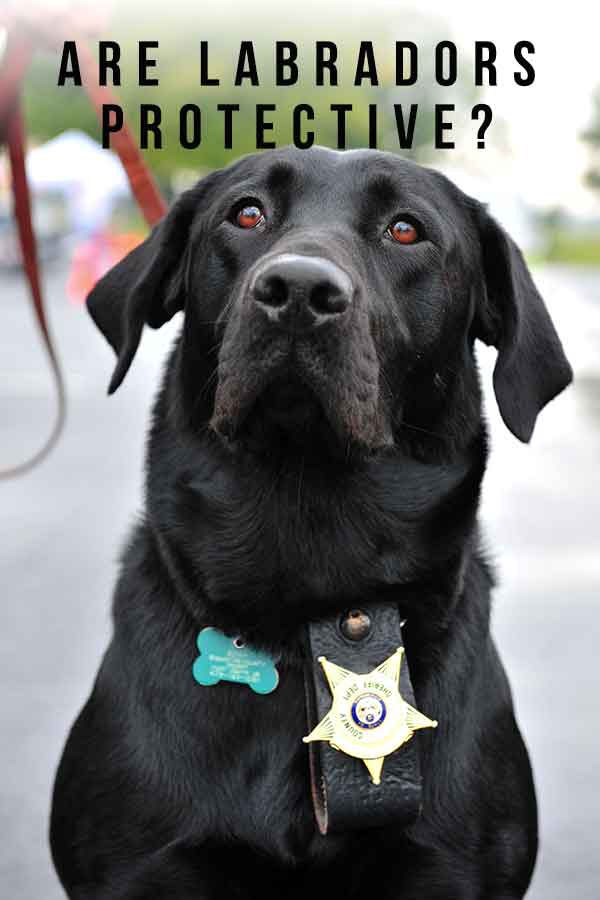The protective behavior displayed by dogs is mostly innate and not easily trainable. Labrador Retrievers, while not commonly associated with strong protective instincts compared to other breeds, are affectionate and devoted companions. Due to their size, simply having a Labrador nearby can make you feel secure. Labrador Retrievers are known for their loving nature rather than being protective in the traditional sense. They may attempt to shield their family from perceived threats, but they generally have a friendly and open demeanor towards most encounters. Do Labs demonstrate protective behavior towards humans? How do their protective instincts differ from guarding instincts? Is it possible to train Labs for protection purposes, such as deterring intruders? While Labradors are more inclined to protect their food than their humans, there are some instances where they may exhibit protective behaviors towards their loved ones. Today, we will explore whether Labradors’ innate protective instincts can be utilized to transform them into effective guard dogs.
What Does Protective Behavior in Labradors Mean? When discussing whether Labradors are protective animals, it is important to understand what protective behavior entails in dogs. Dogs are social animals, with their wild ancestors living in packs. Within these packs, larger and stronger members would protect the weaker and more vulnerable ones from potential threats. This protective behavior was crucial for the survival of the pack as a whole. In our modern households, domestic dogs often view their human and canine companions as part of their pack. As a result, they may exhibit protective behavior towards them, especially when faced with unfamiliar visitors or perceived threats. Do All Dogs Exhibit Protective Behavior? All dog breeds have the capacity for protective behavior, although young puppies are typically not protective themselves. Instead, they rely on others for protection. Protective behaviors commonly emerge during adolescence, as dogs reach social maturity. There is no clear distinction in protective behavior between male and female dogs. However, a female dog that has not demonstrated protective aggression in the past may exhibit such behavior while caring for a litter of puppies. Additionally, dogs of either sex may display heightened protective instincts when a new baby becomes part of the household.

The concept of protection versus possession can sometimes be misunderstood when it comes to dogs. Many dogs, such as Labrador Retrievers, may exhibit protective behavior over resources they value highly. It is important to understand that protecting family members should not be confused with resource guarding. Some veterinarians caution against including humans in the category of things that can be resource guarded, as possessive aggression and protective aggression are not the same. Possessive aggression, also known as resource guarding, is when a dog tries to keep something desirable to themselves. On the other hand, protective aggression is when a dog tries to prevent harm to someone they consider as “one of their own.” It’s essential to recognize that a Labrador Retriever that resource guards may not necessarily be protective as well.
Do Labradors Protect Their Owners? Labradors are typically not known for being strong protectors of their owners, as some studies suggest that they are more inclined to protect their home or territory rather than their owner. While excessive protection of their owner can be a common behavior issue among dogs, it can be challenging and costly to address. To understand why Labradors may not be very protective, it’s important to consider what drives a dog to act protectively in the first place. Protective aggression in dogs, especially in breeds like German Shepherds and Mastiffs, is often innate and linked to a natural wariness of unfamiliar people, animals, and situations. These breeds are typically trained to guard by forming strong social bonds with their charges, which leads to protective behavior without the need for explicit training. In contrast, Labradors lack the genetic predisposition for protective behavior and are known for their friendly and sociable nature. While they can form strong bonds with their family or other animals, they may not instinctively distrust strangers or intruders. As a result, Labradors may not perceive a threat that requires protective action and are more likely to greet strangers with enthusiasm rather than aggression. However, it’s essential to remember that even a friendly Labrador can exhibit protective behavior if they feel threatened or uncomfortable. Aggression should always be a last resort for dogs, and they will typically display warning signs like growling or baring their teeth before resorting to physical aggression. It’s crucial to respect these signals and avoid pressuring a dog into situations that make them uncomfortable, regardless of their breed. Despite their lack of inherent protective instincts, Labradors are known for their loyalty and affection towards their owners. Protective behavior towards strangers does not necessarily reflect a dog’s feelings towards their owner, and a Labrador can still be a devoted companion even without being a vigilant protector.




